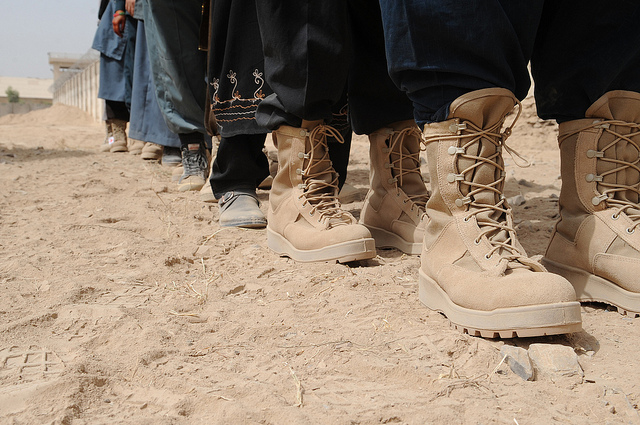
South Asia in 2016 presented a mixed picture for counterterrorism. Excluding those in Afghanistan, fatalities from terrorist violence among all categories of victim—members of the public, security forces and, indeed, terrorists—are at their lowest levels in more than a decade. Civilian casualties have fallen every year since 2013, standing at 857 in 2016, around 6% of the decade’s peak of 14,196 in 2009. Progress has been most significant in Pakistan, in part owing to a years-long military offensive against Pakistani Taliban strongholds.
However, these relative gains have had limited overall impact: South Asia continues to have two of the five countries with the highest proportions of deaths from terrorism, and three of the top eight countries affected by terrorism. Analysis shows elevated levels of terrorism in the late 2000s, driven upwards by the Pakistani Taliban, falling thereafter and then showing another significant period of decline from 2013 to 2016. Despite national and international CT efforts, the Afghan Taliban have made substantial territorial gains across Afghanistan. Islamic State (IS) has continued to mount attacks and Pakistani terrorist groups escalated their attacks in India during this period.
An examination on the counterterrorism situation in South Asia drive five general conclusions about the region’s CT prognosis.
First, at the broadest level, terrorism in South Asia is declining, but is still at high levels and is changing in shape. Both al-Qaeda and IS have been placed under sustained and severe military pressure in Afghanistan, with the result that IS is shrinking and is now confined to a small geographical area. However, IS remains capable of capitalising on the weakness and fragmentation of larger insurgent groups both in Afghanistan and Pakistan. There’s a threat of sectarian terrorism from IS and local groups and partnerships between the two groups in Pakistan. Existing counterterrorism measures have impacted the Pakistani Taliban hard, but are failing to prevent mass-casualty and sectarian attacks.
Second, South Asian CT policy is especially challenging because of state sponsorship of terrorist groups, notably by Pakistan. Larger terrorist acts are consequently seen by regional countries as acts of war, and it’s harder to observe, disrupt and degrade groups being sheltered on foreign soil. The reinvigoration of JeM, the continued activity of LeT, mass protest and unrest in Kashmir, and India’s new willingness to conduct public strikes over the LoC point to significant risks of conflict in the absence of meaningful, sustained and visible actions by Pakistan against those proxy forces. Pakistan has intensified its claims that India and Afghanistan sponsor Islamist, nationalist and ethnic armed groups within Pakistan. Although Afghanistan has in the past engaged with and tolerated elements of the Pakistani Taliban on its soil, the evidence for Pakistan’s sweeping claims remains very limited. However, such accusations are likely to grow in significance over 2017 as regional tensions grow and as New Delhi seeks to apply diplomatic pressure on Islamabad.
Third, the most important shift in regional counterterrorism in 2016 was India’s willingness to conduct publicly announced cross-border military raids. While such raids have occurred in the past, their public avowal increases popular support for this type of action and creates greater escalatory pressures. Whether the raids have a deterrent effect on the Pakistan Army’s support for terrorist groups can only be judged some time into 2017, particularly as a new Pakistan Army chief settles into office. India will continue to place CT at the heart of its diplomacy and military preparedness, not least as important state-level elections across the country raise the stakes for Indian politicians.
Fourth, counterterrorism policy in South Asia continues to be highly politicised, and civil society groups claim that counterterrorism legislation and anti-terrorism forces are used to curb legitimate political activity. Those concerns have been greatest in Pakistan, Bangladesh and Sri Lanka, although India has also used broad legislation to target dissent on the issue of Kashmir. That’s in part a function of highly contentious politics, in which the rules of the political game aren’t settled and incumbents sometimes use state institutions to increase the barriers to entry for opponents. At the international level, strategic rivalries also politicise counterterrorism, as seen with China’s repeated efforts through 2016 to shield Pakistan-based terrorists from designation at the UN.
Fifth, South Asia is characterised by limited state capacity in law enforcement, intelligence and broader national security. That’s most evident during terrorist attacks, when poor standards of defensive and offensive equipment, low preparedness and poor management and oversight have led to incidents being more prolonged and destructive than might otherwise have been the case. Even India, which is the wealthiest South Asian nation and has undertaken significant institutional improvements since the 2008 Mumbai attacks, has had uneven operational responses to attacks in and around Kashmir over 2015 and 2016.
In Pakistan’s case, during the October 2016 Quetta attack, the attackers were able to breach a mud wall at the police academy, which had not been hardened despite two previous attacks on the same site. Other institutional failings include poor investigative techniques, limited cooperation between competing intelligence and security agencies and poor border security, which in turn facilitates the flow of people, arms and illicit substances in a trade that may benefit terrorist organisations. Addressing these failings and building resilience is likely to be one of the most effective forms of counterterrorism that could be pursued.

